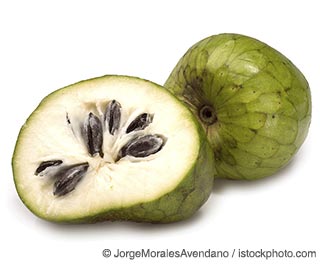Three Cheers for Cherimoya!
Botanical name: Annona cheirimola

Native to the valleys of southern Ecuador and northern Peru, cherimoya is unheard of by many Americans, since it has somewhat demanding growing preference.1 One of the most crucial factors in cultivating cherimoya is high temperature, which thwarts the plant's growth and fruit production. Leaf shrinking and discoloration were both observed in cherimoya trees planted under direct light.2
In the late 1800s, about 9,000 cherimoya trees were introduced to California, but most of them died due to the low temperatures, with the same happening to cherimoyas planted in Florida, with the trees producing poor-quality fruits upon harvest.3
Outside of America, cherimoya is known on nearly every continent, from Egypt to Hawaii. It's sometimes known as cherimolia or chirimolla. It is also referred to as "pap" or "tsummy" in Guatemala, and "anone" in France.4 It belongs to the same family as soursop, pawpaw and sugar apple.5
Cherimoya fruits are typically conical, with some people describing them as heart-shaped. The fruits can be easily broken, exposing its white and juicy flesh. The different varieties of cherimoya may differ in fruit shape and texture, but they all offer the same sweet flavor.
Cherimoya fruits are usually eaten by hand or scooped out with a spoon. The sweetness of the fruit is natural and usually doesn't require anything to accentuate it, but some people prefer adding a few drops of lime juice. It can also be added to fruit salads or made into ice cream or sherbet.6 Because of its sheer sweetness, Mark Twain described the cherimoya as "the most delicious fruit known to men."7
Health Benefits of Cherimoya
One of the principal components of cherimoya is its antioxidant content. In a study from Food Research International, the skin, flesh and juice of cherimoya were found to contain significant levels of antioxidant activity, with the juice having the highest percentage. Because of this, regular consumption of cherimoya may help combat numerous conditions, such as cardiovascular disease, cancer and other disorders linked to oxidative damage.8,9
Cherimoya provides high potassium levels, which helps control heart rate and blood pressure.10,11 Furthermore, it contains more minerals per weight than a lot of more common fruits, such as apples, because of its magnesium, iron and phosphorus content.12,13
In rural Mexico, cherimoya seeds are sometimes roasted, peeled and pulverized into a powder and mixed with water or milk. This mixture is then used as a cathartic or an emetic. It can also be mixed with grease and used to kill lice.14
Cherimoya Nutrition Facts
Serving Size: 3.5 ounces (100 grams), raw15
| Calories |
75 |
|
| Total Fat |
0.68 g |
|
| Saturated Fat |
0.233 g |
|
| Trans Fat |
|
|
| Cholesterol |
0 mg |
|
| Sodium |
7 mg |
|
| Total Carbohydrates |
17.71 g |
|
| Dietary Fiber |
3 g |
|
| Sugar |
12.87 g |
|
| Protein |
1.57 g |
|
| Calcium 10 mg |
Iron |
287 mg |
Studies Done on Cherimoya
Used in traditional Mexican medicine for its anxiety-relieving, anticonvulsant and tranquilizing properties, cherimoya was studied for possible development of medicine for depressive disorder. In a study from the Journal of Ethnopharmacology, repeated test treatments of cherimoya in a lab setting produced antidepressant-like effects in mice. It was strongly suggested by scientists that it be used in that capacity as an antidepressant medium.16
Cherimoya has also been studied for its possible role in cancer treatment. In a study published in the Journal of Agricultural Science, cherimoya and avocado extracts were observed to have cytotoxic and mitodepressive properties, which may be helpful in arresting the development of cancer cells.17 However, another study found certain annona cultivars to induce Parkinson's disease-like symptoms, ostensibly due to the phytochemical annonacin content, which is also found in cherimoya seeds.18,19
Cherimoya Healthy Recipes:
Cherimoya Ice Cream

|
Ingredients:
|
|
✓ 4 to 6 ripe cherimoyas
|
✓ Water
|
Procedure:
- Scoop the flesh from ripe cherimoya into the bowl of a food processor, without the peel and large seeds. Blend until it forms a paste.
- Scrape paste onto a container and put it in the freezer for four to five hours or overnight, until it is frozen solid.
- Remove cherimoya from freezer, and use your hands to break it up into pieces. Place the frozen pieces in a food processor and process into a thick paste. Add a tablespoon or more of water (a bit at a time), until it looks like ice cream. Avoid over mixing so it will not melt and become slushy.
- Scoop into bowls and enjoy!
This recipe makes 4 to 6 servings.
(Adapted from Shockingly Delicious20)
Cherimoya Fun Facts
Cherimoya pollination is a challenge, because the male and female flowers mature at different times. The scarcity in pollinators also doesn't help. To help cherimoya fruits to develop, hand pollinating may be required, which usually takes up to eight hours. The process starts in the afternoon, collecting partly opened flowers. They are then kept in paper bags until the next morning, when the pollen is brushed on the stigmas.21
Summary
Commercial production of cherimoya fruit is a challenge because of its short shelf life, cultivation demands and time-intensive hand-pollination requirements. But it's worth it!
Often considered one of the best-tasting fruits in the world, cherimoyas are becoming more popular in the U.S. for their rich, creamy texture and sweet flavor, which makes excellent smoothies and tea. This exotic tropical fruit is native to the Andes Mountain region, but grows in similar, moderate climates throughout the world, including Southern California. Its nutritional benefits include vitamins A and C, copper, magnesium, iron and manganese, and there is a growing conversation regarding its possible cancer-inhibiting capabilities.
However, be sure to consume cherimoyas in moderation because they contain fructose, which can be harmful to your health in excessive amounts.